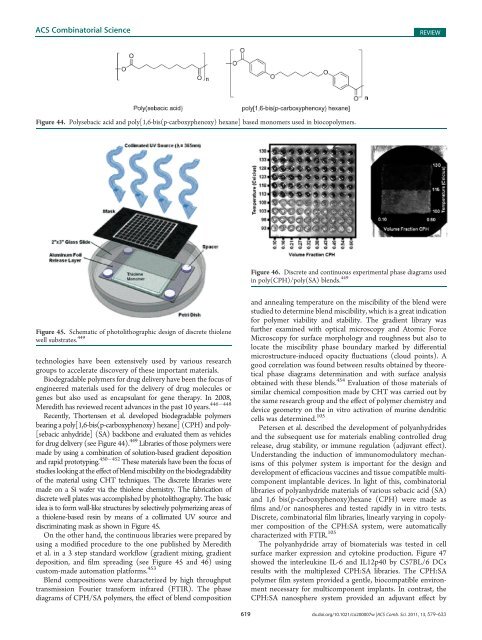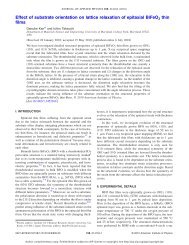Combinatorial and High-Throughput Screening of Materials ...
Combinatorial and High-Throughput Screening of Materials ...
Combinatorial and High-Throughput Screening of Materials ...
You also want an ePaper? Increase the reach of your titles
YUMPU automatically turns print PDFs into web optimized ePapers that Google loves.
ACS <strong>Combinatorial</strong> Science<br />
REVIEW<br />
Figure 44. Polysebacic acid <strong>and</strong> poly[1,6-bis(p-carboxyphenoxy) hexane] based monomers used in biocopolymers.<br />
Figure 46. Discrete <strong>and</strong> continuous experimental phase diagrams used<br />
in poly(CPH)/poly(SA) blends. 449<br />
Figure 45. Schematic <strong>of</strong> photolithographic design <strong>of</strong> discrete thiolene<br />
well substrates. 449<br />
technologies have been extensively used by various research<br />
groups to accelerate discovery <strong>of</strong> these important materials.<br />
Biodegradable polymers for drug delivery have been the focus <strong>of</strong><br />
engineered materials used for the delivery <strong>of</strong> drug molecules or<br />
genes but also used as encapsulant for gene therapy. In 2008,<br />
446 448<br />
Meredith has reviewed recent advances in the past 10 years.<br />
Recently, Thortensen et al. developed biodegradable polymers<br />
bearing a poly[1,6-bis(p-carboxyphenoxy) hexane] (CPH) <strong>and</strong> poly-<br />
[sebacic anhydride] (SA) backbone <strong>and</strong> evaluated them as vehicles<br />
for drug delivery (see Figure 44). 449 Libraries <strong>of</strong> those polymers were<br />
made by using a combination <strong>of</strong> solution-based gradient deposition<br />
<strong>and</strong> rapid prototyping. 450 452 These materials have been the focus <strong>of</strong><br />
studies looking at the effect <strong>of</strong> blend miscibility on the biodegradability<br />
<strong>of</strong> the material using CHT techniques. The discrete libraries were<br />
made on a Si wafer via the thiolene chemistry. The fabrication <strong>of</strong><br />
discrete well plates was accomplished by photolithography. The basic<br />
idea is to form wall-like structures by selectively polymerizing areas <strong>of</strong><br />
a thiolene-based resin by means <strong>of</strong> a collimated UV source <strong>and</strong><br />
discriminating mask as shown in Figure 45.<br />
On the other h<strong>and</strong>, the continuous libraries were prepared by<br />
using a modified procedure to the one published by Meredith<br />
et al. in a 3 step st<strong>and</strong>ard workflow (gradient mixing, gradient<br />
deposition, <strong>and</strong> film spreading (see Figure 45 <strong>and</strong> 46) using<br />
custom-made automation platforms. 453<br />
Blend compositions were characterized by high throughput<br />
transmission Fourier transform infrared (FTIR). The phase<br />
diagrams <strong>of</strong> CPH/SA polymers, the effect <strong>of</strong> blend composition<br />
<strong>and</strong> annealing temperature on the miscibility <strong>of</strong> the blend were<br />
studied to determine blend miscibility, which is a great indication<br />
for polymer viability <strong>and</strong> stability. The gradient library was<br />
further examined with optical microscopy <strong>and</strong> Atomic Force<br />
Microscopy for surface morphology <strong>and</strong> roughness but also to<br />
locate the miscibility phase boundary marked by differential<br />
microstructure-induced opacity fluctuations (cloud points). A<br />
good correlation was found between results obtained by theoretical<br />
phase diagrams determination <strong>and</strong> with surface analysis<br />
obtained with these blends. 454 Evaluation <strong>of</strong> those materials <strong>of</strong><br />
similar chemical composition made by CHT was carried out by<br />
the same research group <strong>and</strong> the effect <strong>of</strong> polymer chemistry <strong>and</strong><br />
device geometry on the in vitro activation <strong>of</strong> murine dendritic<br />
cells was determined. 105<br />
Petersen et al. described the development <strong>of</strong> polyanhydrides<br />
<strong>and</strong> the subsequent use for materials enabling controlled drug<br />
release, drug stability, or immune regulation (adjuvant effect).<br />
Underst<strong>and</strong>ing the induction <strong>of</strong> immunomodulatory mechanisms<br />
<strong>of</strong> this polymer system is important for the design <strong>and</strong><br />
development <strong>of</strong> efficacious vaccines <strong>and</strong> tissue compatible multicomponent<br />
implantable devices. In light <strong>of</strong> this, combinatorial<br />
libraries <strong>of</strong> polyanhydride materials <strong>of</strong> various sebacic acid (SA)<br />
<strong>and</strong> 1,6 bis(p-carboxyphenoxy)hexane (CPH) were made as<br />
films <strong>and</strong>/or nanospheres <strong>and</strong> tested rapidly in in vitro tests.<br />
Discrete, combinatorial film libraries, linearly varying in copolymer<br />
composition <strong>of</strong> the CPH:SA system, were automatically<br />
characterized with FTIR. 105<br />
The polyanhydride array <strong>of</strong> biomaterials was tested in cell<br />
surface marker expression <strong>and</strong> cytokine production. Figure 47<br />
showed the interleukine IL-6 <strong>and</strong> IL12p40 by C57BL/6 DCs<br />
results with the multiplexed CPH:SA libraries. The CPH:SA<br />
polymer film system provided a gentle, biocompatible environment<br />
necessary for multicomponent implants. In contrast, the<br />
CPH:SA nanosphere system provided an adjuvant effect by<br />
619 dx.doi.org/10.1021/co200007w |ACS Comb. Sci. 2011, 13, 579–633












